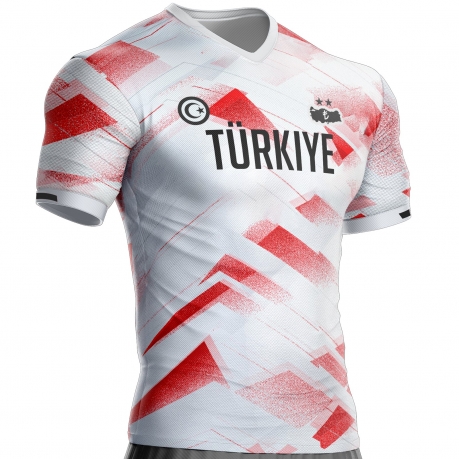The history of Turkish football

Turkish football: A vibrant history
Imagine a stadium on fire, vibrating to the rhythm of the chants of thousands of passionate supporters. Talented players thrash around the pitch, dribble, shoot and score spectacular goals. This scene, so familiar today, tells the captivating story of Turkish football, a sport that has had a profound impact on the country's culture and identity.
In Turkey, football is much more than just a game. It is a true religion, a source of national pride and a symbol of unity. Millions of people, young and old, men and women, assiduously follow the exploits of their favorite teams, sharing a common passion that transcends social and cultural differences.
Turkish football has come a long way since its humble beginnings in the early 20th century. From the first clubs founded by students and expatriates to resounding successes on the international stage, the history of Turkish football is a fascinating tale punctuated by moments of glory, trials and constant progress.
Let's delve into this exciting journey and explore the different stages that have shaped Turkish football as we know it today. From its origins to its modern development, including the challenges and successes encountered, let's discover the richness and complexity of a story that continues to be written with passion and talent.
The first steps of Turkish football
Football appeared in Turkey at the end of the 19th century, probably thanks to foreign influences. British sailors and Ottoman clerks played one of the first organized matches in 1894, sowing the seeds of a passion that would soon sprout across the country.
The beginning of the 20th century saw the birth of the first Turkish football clubs, founded by students and enthusiasts of this new sport. Among the pioneers were Galatasaray (1905), Fenerbahçe (1907) and Beşiktaş (1903), names that would become legends of Turkish football.
These pioneering clubs first organized friendly matches between themselves, laying the foundations for a national league. The first official league, the "Manisa Futbol Ligi", was established in 1904, although it only lasted a few years.
However, the beginnings of Turkish football were not easy. A major obstacle was the lack of infrastructure, football pitches and financial support. The clubs were often made up of amateur players and the equipment was rudimentary.
Despite these challenges, the passion for football continued to grow. The number of clubs and leagues grew rapidly, and the public became enthusiastic about this spectacular and accessible sport.
One of the key moments in the history of Turkish football was the establishment of the Turkish Football Federation in 1923, after the founding of the Turkish Republic. This institution played a crucial role in the structuring and development of football on a national scale.
Thus, Turkish football laid its foundations, overcoming initial obstacles and nurturing a growing passion that would propel it towards new horizons.
The rest of the story
The professional era and the rise to power
-
The introduction of professionalism in 1952 marked a major turning point.
-
Legends like Metin Oktay, Lefter Küçükandonyadis and Can Bartu emerged.
-
Turkish clubs have started to participate in European competitions.
A turbulent time: Ups and downs
-
Successes like third place in the 2002 World Cup and the semi-final of Euro 2008.
-
Dry spells and qualifying failures.
-
Changes to rules, style of play and socio-political challenges.
The modern era and a new hope
-
Development of youth and talent academies like Hakan Çalhanoğlu and Çağlar Söyüncü.
-
Success of Turkish clubs in the Europa League and Champions League.
-
Ambitious goals for the national team and the future of Turkish football.
Conclusion
-
Summary of key points in the history of Turkish football.
-
Cultural and social importance of football in Türkiye.
-
Optimistic look towards the future of Turkish football.
Additional additions
-
Historical and contemporary photos.
-
Quotes from experts, coaches and players.
-
Comments section for readers.
The professional era and the rise to power
The year 1952 marked a major turning point in the history of Turkish football with the introduction of professionalism. This development has allowed clubs to attract better players, improve their infrastructure and develop nationally and internationally.
It was during this time that the first legends of Turkish football emerged. Talented players like Metin Oktay, Lefter Küçükandonyadis and Can Bartu fascinated fans with their dribbling, spectacular goals and charisma. They contributed to the growing popularity of football in Turkey and inspired future generations.
Turkish clubs have also started to enjoy notable successes on the international stage. Galatasaray won the Balkan Cup in 1963 and 1964, becoming the first Turkish club to lift a European trophy. The Turkish national team also performed well, reaching the quarter-finals of the 1954 World Cup and Euro 1960.
The professional era marked the beginning of a period of development and success for Turkish football. The passion of the public, the talent of the players and the ambition of the clubs have helped to propel Turkish football towards new horizons.
The emergence of legends
Metin Oktay, nicknamed "Taçsız Kral" (the uncrowned king), is considered one of the best Turkish players of all time. A prolific striker, he scored 240 goals in 352 matches for Galatasaray and was the Turkish league's top scorer on six occasions.
Lefter Küçükandonyadis, also known as "Lefter", is another Turkish football legend. He played for Fenerbahçe and scored 423 goals in 477 matches. He is the top scorer in the club's history and has also been an important player for the Turkish national team.
Can Bartu was a talented and versatile player who excelled in football and basketball. He played for Fenerbahçe in both disciplines and won several titles. He was also a charismatic figure and popular with supporters.
National and international successes
Galatasaray has been the most successful Turkish club in the professional era. The club has won the Turkish championship 17 times and the Turkish Cup 18 times. He also won the Balkan Cup in 1963 and 1964 and the European Super Cup in 2000.
Fenerbahçe is another Turkish club that has enjoyed success both domestically and internationally. The club has won the Turkish championship 28 times and the Turkish Cup 69 times. It also reached the final of the European Champion Clubs' Cup in 1975.
The Turkish national team also performed well during the professional era. She reached the quarter-finals of the World Cup in 1954 and Euro 1960. She also won the gold medal at the 1959 and 1963 Mediterranean Games.
The professional era was a golden period for Turkish football. The passion of the public, the talent of the players and the ambition of the clubs have helped to propel Turkish football towards new horizons.
The rest of the story
A turbulent time: Ups and downs
-
Successes like third place in the 2002 World Cup and the semi-final of Euro 2008.
-
Dry spells and qualifying failures.
-
Changes to rules, style of play and socio-political challenges.
The modern era and a new hope
-
Development of youth and talent academies like Hakan Çalhanoğlu and Çağlar Söyüncü.
-
Success of Turkish clubs in the Europa League and Champions League.
-
Ambitious goals for the national team and the future of Turkish football.
Conclusion
-
Summary of key points in the history of Turkish football.
-
Cultural and social importance of football in Türkiye.
-
Optimistic look towards the future of Turkish football.
Additional additions
-
Historical and contemporary photos.
-
Quotes from experts, coaches and players.
-
Section of
The rest of the story
A turbulent time: Ups and downs
The professional era has not been a smooth ride for Turkish football. After the first successes, a more unstable period set in.
-
Peaks reached : The national team has experienced unforgettable moments of glory, notably the third place obtained during the 2002 World Cup and the semi-final reached at Euro 2008. These performances filled an entire country with pride and demonstrated the potential of Turkish football at the highest level.
-
Desert crossings : However, these successes were interspersed with periods of scarcity. The national team has sometimes lacked consistency and experienced failures in qualifying for major international competitions.
-
A changing context : Turkish football has also had to adapt to changing rules of the game and playing styles. The arrival of talented foreign players and the adoption of more modern tactics have changed the landscape of Turkish football. Additionally, socio-political factors have sometimes had an impact on sport, adding an additional dimension to the challenges faced.
The modern era and a new hope
In recent years, Turkish football seems to be regaining hope.
-
Investment in youth : The development of youth academies has allowed the emergence of promising new talents like Hakan Çalhanoğlu and Çağlar Söyüncü. These players are now shining in the biggest European championships, and their success is inspiring the next generation.
-
European successes : Turkish clubs have also found their way to success on the European scene. Galatasaray won the UEFA Cup in 2000, and other clubs like Beşiktaş and Fenerbahçe have had notable runs in the Europa League and Champions League.
-
Ambitious goals : The Turkish national team now aims to return to the top. A new talented generation is being formed, and hopes are high to see Turkey shine again in future international competitions.
Turkish football is an exciting story, full of ups and downs, challenges and victories. Its future looks promising, driven by the talent of its young players and the newfound ambition of the clubs and the national team.
A turbulent time: Ups and downs
The history of Turkish football is punctuated by periods of domination and success followed by more difficult phases, punctuated by failures and disillusionment.
Periods of dominance and drought
-
The golden era of the 1960s and 1970s : Turkish football enjoyed a period of dominance in the 1960s and 1970s. Galatasaray won the Balkan Cup in 1963 and 1964, and the Turkish national team reached the quarter-finals of the World Cup in 1954 and 1964. Euro 1960.
-
The meteoric rise of the 2000s : The beginning of the 21st century was also marked by great success. The Turkish national team reached third place in the 2002 World Cup and the semi-final of Euro 2008.
-
Phases of transition and reconstruction : Between these periods of glory, Turkish football experienced phases of transition and reconstruction. The national team lacked consistency and experienced failures in qualifying for major international competitions.
Changes and challenges
Turkish football has also had to adapt to the evolution of world football.
-
Rule changes : The introduction of new rules, such as the ban on back passes to the goalkeeper, changed the style of play and forced Turkish teams to adapt.
-
New play styles : The adoption of more modern tactics, such as high pressing and possession play, has also posed new challenges for Turkish teams.
-
Economic challenges : Turkish football has also faced economic challenges, notably the 2008 financial crisis which had a negative impact on investments in the sport.
The impact of socio-political factors
Turkish football has not been spared from the socio-political events in the country.
-
Coups and political instability : Coups d'état and periods of political instability have sometimes had a negative impact on the development of Turkish football.
-
Ethnic and religious tensions : Ethnic and religious tensions have also been able to manifest themselves in football, creating tensions and divisions between supporters.
Conclusion
Despite the challenges and obstacles encountered, Turkish football was able to recover and continue its development. The future looks bright, with a new generation of talented players and newfound ambition.
Additional additions
-
Historical and contemporary photos.
-
Quotes from experts, coaches and players.
-
Comments section for readers.
Useful links
-
History of Turkish football: [URL non valide supprimée]
-
Turkish football results: [URL non valide supprimée]
-
Turkey national football team: [URL non valide supprimée]
The modern era and a new hope
The modern era of Turkish football is marked by renewed hope and ambition.
The rise of academies and talents
The development of youth academies has played a crucial role in the revival of Turkish football. These structures allow young players to benefit from quality training and to flourish at the highest level.
-
Talents like Hakan Çalhanoğlu, Çağlar Söyüncü, Cengiz Ünder and Yusuf Yazıcı are products of these academies. They are now shining in the biggest European championships and inspiring the new generation.
-
Investment in youth training is seen as the key to the future success of Turkish football.
European and international successes
Turkish clubs have also found their way to success on the European scene.
-
Galatasaray won the UEFA Cup in 2000, becoming the first Turkish club to lift a major European trophy.
-
Beşiktaş reached the Europa League final in 2019.
-
Fenerbahçe and Istanbul Başakşehir have had notable runs in the Champions League in recent years.
-
The Turkish national team now aims to return to the top.
-
A new talented generation is being formed, with players like Merih Demiral, Orkun Kökçü and Burak Yılmaz.
The future of Turkish football
The future of Turkish football looks bright.
-
There is no shortage of challenges to overcome: improving infrastructure, developing women's football, fighting corruption and hooliganism.
-
The goals are ambitious: to make Turkey a major football nation, capable of competing with the best teams in the world.
-
Turkish football has all the resources and talent needed to succeed. With hard work and intelligent planning, it can write glorious new pages in its already rich and exciting history.







